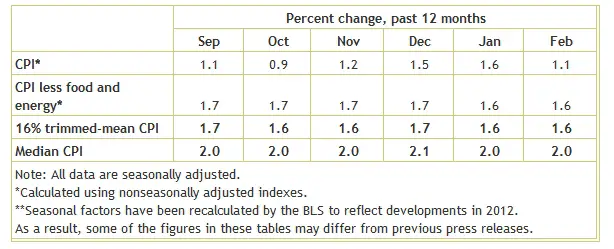The Federal Reserve
The Federal Reserve serves as the Central Bank of the United States, and whether you realize it or not, it plays an active role in the lives of every American. It makes decisions about monetary policy and interest rates that have a direct impact on the market and an indirect impact on everyone. The FED uses inflation targets to determine how much they can devalue (inflate) the currency. Many people believe that they created a massive money printing scheme cryptically called “Quantitative Easing“since QE1 converted almost worthless mortgage backed securities into currency.
The Fed regularly issues statements about how inflation isn’t really as bad as everyone says it is. The U.S. Bureau of Labor Statistics (BLS) tracks inflation and publishes the Consumer Price Index (CPI) in a variety of flavors including the CPI-U which is the Consumer Price Index for all Urban Consumers. Many believe that the CPI-U underestimates the level of inflation. See Can We Trust Government Inflation Numbers? One subset of the CPI-U that gets lots of press is the “Core CPI” which excludes the volatile components of food and energy.
The Federal Reserve and the Core CPI
 In the past, the Federal Reserve used the standard consumer price index to determine how much inflation was occurring in the market. In 2007, they switched over to a different method of gauging inflation, based on the core CPI or “core inflation.”Their version is called the Median CPI and is published by the Cleveland Federal Reserve Bank.
In the past, the Federal Reserve used the standard consumer price index to determine how much inflation was occurring in the market. In 2007, they switched over to a different method of gauging inflation, based on the core CPI or “core inflation.”Their version is called the Median CPI and is published by the Cleveland Federal Reserve Bank.
According to the Cleveland FED, To calculate the Median CPI, the Federal Reserve Bank of Cleveland looks at the prices of the goods and services published by the BLS. But instead of calculating a weighted average of all of the prices, as the BLS does, the Cleveland Fed looks at the median price change—or the price change that’s right in the middle of the long list of all of the price changes. According to research from the Cleveland Fed, the Median CPI provides a better signal of the inflation trend than either the all-items CPI or the CPI excluding food and energy.
Why The Federal Reserve Switched to Median CPI
In September 2007, the Cleveland FED changed the way it calculates the median consumer price index. This change was made to address a potential problem in the inflation signals they were receiving. The problem resulted from the large weight given to the Owners’ Equivalent Rent (OER) component of the CPI. By breaking the OER into four regional subindexes, the revised methodology improves the ability of the Bank’s trimmed-mean CPI data, particularly the median CPI, to measure underlying inflation trends. See the full report. The following table shows the comparison between the BLS CPI and the Cleveland FED’s Median CPI for September 2013 and February 2014. From this we can see that the FED does not consider inflation as low as the BLS is claiming it is. Also note that the FED’s Median CPI is much more stable than the CPI.
 Editor’s Note:Don’t confuse the FED’s excluding food and energy with the Bureau of Labor statistics. The BLS still calculates the cost of food and energy in their Consumer Price Index (CPI). They also calculate just the inflation due to energy, and inflation just in food and everything minus food and energy, and about every other combination you can think of.
Editor’s Note:Don’t confuse the FED’s excluding food and energy with the Bureau of Labor statistics. The BLS still calculates the cost of food and energy in their Consumer Price Index (CPI). They also calculate just the inflation due to energy, and inflation just in food and everything minus food and energy, and about every other combination you can think of.
See:
- What is the Federal Reserve – Part 1 , Part 2 , Part 3
- Why Buy Gold?
- What is Quantitative Easing?
- Can We Trust Government Inflation Numbers?



Leave a Reply